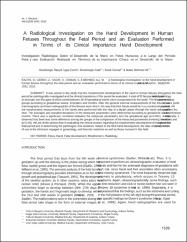Radiological Investigation on the Hand Development in Human Fetuses Throughout the Fetal Period and an Evaluation Performed in Terms of its Clinical Importance Hand Development
Özet
It was aimed in this study that the morphometric development of the hand in human fetuses throughout the fetal period be radiologically investigated and the clinical importance of this period be evaluated. A total of 50 fetuses with no external pathology or anomaly, and the ages of which varied between 20-40 gestational weeks were incorporated into the study. The fetuses were separated into groups according to gestational weeks, trimesters and months. After the general external measurements of the fetuses were performed, mammography and hand radiographies of the fetuses were shot in the way that their hands would be in a pronational position. Afterwards, the morphometric measurements of the hands were performed with the help of a digital caliper through the hand radiographies that were shot. The averages and standard deviations of the measured parameters were determined according to gestational weeks, trimesters and months. There was a significant correlation between the measured parameters and the gestational age (p<0.001). Additionally, it was observed that there was some difference among the groups in the comparison of the measured parameters involving trimesters and months (p<0.05). We are of the opinion that in evaluating the clinical studies regarding the morphometric development of the hand throughout the fetal period and in determining the pathologies and variations related to the fetal hand development, the data obtained in our study will be of use to the clinicians engaged in gynecology, and forensic medicine as well as those involved in this field.


















